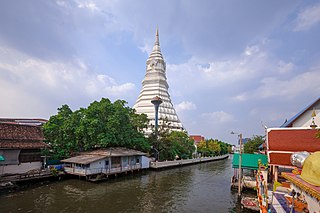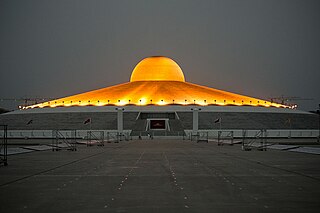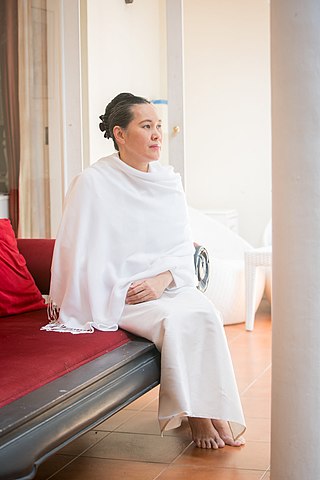
The five precepts or five rules of training is the most important system of morality for Buddhist lay people. They constitute the basic code of ethics to be respected by lay followers of Buddhism. The precepts are commitments to abstain from killing living beings, stealing, sexual misconduct, lying and intoxication. Within the Buddhist doctrine, they are meant to develop mind and character to make progress on the path to enlightenment. They are sometimes referred to as the Śrāvakayāna precepts in the Mahāyāna tradition, contrasting them with the bodhisattva precepts. The five precepts form the basis of several parts of Buddhist doctrine, both lay and monastic. With regard to their fundamental role in Buddhist ethics, they have been compared with the ten commandments in Abrahamic religions or the ethical codes of Confucianism. The precepts have been connected with utilitarianist, deontological and virtue approaches to ethics, though by 2017, such categorization by western terminology had mostly been abandoned by scholars. The precepts have been compared with human rights because of their universal nature, and some scholars argue they can complement the concept of human rights.

Much Buddhist art uses depictions of the historical Buddha, Gautama Buddha, which are known as Buddharūpa in Sanskrit and Pali. These may be statues or other images such as paintings. The main figure in an image may be someone else who has obtained Buddhahood, or a boddhisattva, especially in the various traditions of Mahayana Buddhism. Other Buddhas and bodhisattvas in art have become increasingly common over the centuries, perhaps now outnumbering images of the historical Buddha.

Phra VisuddhisamvaratheraAM, known as Ajahn Brahmavaṃso, or simply Ajahn Brahm, is a British-born Theravada Buddhist monk. Currently, Ajahn Brahm is the abbot of Bodhinyana Monastery in Serpentine, Western Australia; Spiritual Adviser to the Buddhist Society of Victoria; Spiritual Adviser to the Buddhist Society of South Australia; Spiritual Patron of the Buddhist Fellowship in Singapore; Patron of the Brahm Centre in Singapore; Spiritual Adviser to the Anukampa Bhikkhuni Project in the UK; and Spiritual Director of the Buddhist Society of Western Australia (BSWA). He returned to the office on 22 April 2018 after briefly resigning in March, following a contentious vote by members of the BSWA during their annual general meeting.

Buddhism is the second largest religion in Malaysia, after Islam, with 18.7% of Malaysia's population being Buddhist, although some estimates put that figure at 21.6% when combining estimates of numbers of Buddhists with figures for adherents of Chinese religions which incorporate elements of Buddhism. Buddhism in Malaysia is mainly practised by the ethnic Malaysian Chinese, but there are also Malaysian Siamese, Malaysian Sri Lankans and Burmese in Malaysia that practice Buddhism such as Ananda Krishnan and K. Sri Dhammananda and a sizeable population of Malaysian Indians.

Sulak Sivaraksa is a Thai social activist, professor, writer and the founder and director of the Thai NGO "Sathirakoses-Nagapradeepa Foundation", named after two authorities on Thai culture, Sathirakoses and Nagapradeepa. He initiated a number of social, humanitarian, ecological and spiritual movements and organizations in Thailand, such as the College SEM.

Aṅgulimāla is an important figure in Buddhism, particularly within the Theravāda tradition. Depicted as a ruthless brigand who completely transforms after a conversion to Buddhism, he is seen as the example par excellence of the redemptive power of the Buddha's teaching and the Buddha's skill as a teacher. Aṅgulimāla is seen by Buddhists as the "patron saint" of childbirth and is associated with fertility in South and Southeast Asia.

Buddhism in Thailand is largely of the Theravada school, which is followed by roughly 93.4 percent of the population. Thailand has the second largest Buddhist population in the world, after China, with approximately 64 million Buddhists. Buddhism in Thailand has also become integrated with folk religion (Bon), Hinduism from millennia of Indian influence, and Chinese religions from the large Thai Chinese population. Buddhist temples in Thailand are characterized by tall golden stupas, and the Buddhist architecture of Thailand is similar to that in other Southeast Asian countries, particularly Cambodia and Laos, with which Thailand shares cultural and historical heritages. Thai Buddhism also shares many similarities with Sri Lankan Buddhism. Thailand, Cambodia, Myanmar, Sri Lanka and Laos are countries with Theravada Buddhist majorities.
The Dhammakaya tradition or Dhammakaya movement is a Thai Buddhist tradition founded by Luang Pu Sodh Candasaro in the early 20th century. It is associated with several temples descended from Wat Paknam Bhasicharoen in Bangkok.

Wat Paknam Bhasicharoen is a royal wat ('temple') located in Phasi Charoen district, Bangkok, at the Chao Phraya River. It is part of the Maha Nikaya fraternity and is the origin of the Dhammakaya tradition. It is a large and popular temple, supported by prosperous community members.

Wat Phra Dhammakaya is a Buddhist temple (wat) in Khlong Luang district, in the Pathum Thani province north of Bangkok, Thailand. It was founded in 1970 by the maechi (nun) Chandra Khonnokyoong and Luang Por Dhammajayo. It is the best-known and the fastest growing temple of the Dhammakaya tradition. This tradition, teaching Dhammakaya meditation, was started by the meditation master Luang Pu Sodh Candasaro in the early 20th century. Wat Phra Dhammakaya is one of the temples that emerged from this tradition and is part of the Mahā Nikāya fraternity. The temple is legally represented by the Dhammakaya Foundation. It aims to adapt traditional Buddhist values in modern society, doing so through modern technology and marketing methods. The temple has faced controversy and a government crackdown. Wat Phra Dhammakaya plays a leading role in Thai Buddhism, with theologian Edward Irons describing it as "the face of modern Thai Buddhism".

Buddhist art is visual art produced in the context of Buddhism. It includes depictions of Gautama Buddha and other Buddhas and bodhisattvas, notable Buddhist figures both historical and mythical, narrative scenes from their lives, mandalas, and physical objects associated with Buddhist practice, such as vajras, bells, stupas and Buddhist temple architecture. Buddhist art originated in the north of the Indian subcontinent, in modern India, Pakistan and Afghanistan, with the earliest survivals dating from a few centuries after the historical life of Siddhartha Gautama from the 6th to 5th century BCE.
Many adherents of Buddhism have experienced religious persecution because of their adherence to the Buddhist practice, including unwarranted arrests, imprisonment, beating, torture, and/or execution. The term also may be used in reference to the confiscation or destruction of property, temples, monasteries, centers of learning, meditation centers, historical sites, or the incitement of hatred towards Buddhists.

Dhammananda Bhikkhuni, born Chatsumarn Kabilsingh or Chatsumarn Kabilsingh Shatsena, is a Thai bhikkhuni. On 28 February 2003, Kabilsingh received full monastic ordination as a bhikkhuni of the Theravada tradition in Sri Lanka. She is Abbess of Songdhammakalyani Monastery, the only temple in Thailand where there are bhikkhunis.
Buddhist scripture condemns violence in every form. Ahimsa, a term meaning "not to injure", is a primary virtue in Buddhism. However, Buddhists have historically used scriptures to justify violence or form exceptions to commit violence for various reasons. As found in other religious traditions, Buddhism has an extensive history of violence dating back to its inception.

The 969 Movement is a Buddhist nationalist movement opposed to what they see as Islam's expansion in predominantly Buddhist Myanmar (Burma). The three digits of 969 "symbolize the virtues of the Buddha, Buddhist practices and the Buddhist community". The first 9 stands for the nine special attributes of the Buddha and the 6 for the six special attributes of his Dharma, or Buddhist Teachings, and the last 9 represents the nine special attributes of Buddhist Sangha. Those special attributes are the Three Jewels of the Buddha. In the past, the Buddha, Sangha, Dhamma, the wheel of Dhamma, and "969" were Buddhist signs.
Ashin Wirathu is a Burmese Buddhist monk, and the leader of the 969 Movement in Myanmar. He has incited the persecution of Muslims in Myanmar through his speeches. Facebook banned his page on the charge of allegedly spreading religious hatred towards other communities, after repeated warnings to not post religiously inflammatory content.
There are references in Jain texts to various areas of Southeast Asia. During the reign of Samprati, Jain teachers were sent to various Southeast Asian countries.

The National Council for Peace and Order was the military junta that ruled Thailand between its 2014 Thai coup d'état on 22 May 2014 and 16 July 2019. On 20 May 2014, the military declared martial law nationwide in an attempt to stop the country's escalating political crisis, and to force the democratically elected government out of office. On 22 May, the military removed the Yingluck Shinawatra government and formed the NCPO to take control of the country. The junta censored the broadcasting system in Thailand, suspended most of the constitution, and detained members of the Thai cabinet. The NCPO was formally dissolved following the swearing-in of the new cabinet on 16 July 2019. Critics like former Thai ambassador Pithaya Pookaman charge that the NCPO "...is practically still very much intact. Its arbitrary power[s] ... transferred to the existing Internal Security Operations Command chaired by the prime minister."

Wat Phra Dhammakaya is a Buddhist temple in Thailand. It was founded in 1970 by the maechi (nun) Chandra Khonnokyoong and Luang Por Dhammajayo. The temple's founding has roots in the Dhammakaya tradition founded by Luang Pu Sodh Candasaro at Wat Paknam Bhasicharoen in the early 20th century. Wat Phra Dhammakaya is known for its modern dissemination methods and use of technology.

Acharavadee Wongsakon is a Thai lay Buddhist teacher and former entrepreneur who teaches a form of Vipassana meditation called Techo Vipassana Meditation. She is the founder of the Knowing Buddha Organization, which campaigns against disrespectful uses of Buddha imagery and the general decline of morality in society. Acharvadee and the Knowing Buddha Foundation have been endorsed by the National Office of Buddhism.














